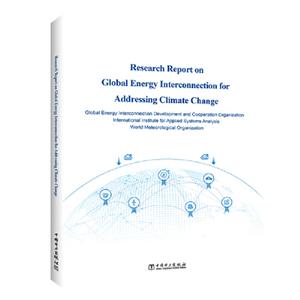-
>
公路車寶典(ZINN的公路車維修與保養秘籍)
-
>
晶體管電路設計(下)
-
>
基于個性化設計策略的智能交通系統關鍵技術
-
>
花樣百出:貴州少數民族圖案填色
-
>
山東教育出版社有限公司技術轉移與技術創新歷史叢書中國高等技術教育的蘇化(1949—1961)以北京地區為中心
-
>
鐵路機車概要.交流傳動內燃.電力機車
-
>
利維坦的道德困境:早期現代政治哲學的問題與脈絡
全球能源互聯網應對氣候變化研究報告(英文版) 版權信息
- ISBN:9787519832223
- 條形碼:9787519832223 ; 978-7-5198-3222-3
- 裝幀:平裝-膠訂
- 冊數:暫無
- 重量:暫無
- 所屬分類:>>
全球能源互聯網應對氣候變化研究報告(英文版) 本書特色
The Report consists of seven chapters. Chapter 1 describes the scientific facts and impacts of climate change and analyzes its status quo and actions as well as the key role of energy transition in addressing it. Climate service for energy is needed to support the transition to clean energy. This chapter is jointly written by WMO and GEIDCO. Chapter 2 explains the framework and theory of GEI mitigation and puts forward its mechanisms and pathways. Chapter 3 deals with the quantitative analysis of the characteristics and mitigation value of the GEI system by using a comprehensive assessment modelling framework in conjunction with energy system and power system optimization models. Chapter 4 focuses on the GEI mitigation technology portfolio, as well as the development trend and combined use of such technologies as clean replacement, electricity replacement, grid interconnection, energy efficiency enhancement, and carbon removal. Chapter 3 and 4 are jointly written by IIASA and GEIDCO. Chapter 5 studies and proposes key mitigation actions through energy interconnection in different continents based on their respective conditions of climate, resource endowment, and energy and power development. Chapter 6 analyzes the contribution of GEI to economy, society, climate, environment, health and sustainable development. Chapter 7 suggests some innovative mechanisms for addressing climate change, including linking mitigation targets with integrated policy instruments, mobilizing finance resources through the electricity-carbon market, accelerating major projects’ implementation by an innovative mode of “electricity, mining, metallurgy, industry and trade” and adopting new approaches for universal power access to enhance climate resilience.The Report consists of seven chapters. Chapter 1 describes the scientific facts and impacts of climate change and analyzes its status quo and actions as well as the key role of energy transition in addressing it. Climate service for energy is needed to support the transition to clean energy. This chapter is jointly written by WMO and GEIDCO. Chapter 2 explains the framework and theory of GEI mitigation and puts forward its mechanisms and pathways. Chapter 3 deals with the quantitative analysis of the characteristics and mitigation value of the GEI system by using a comprehensive assessment modelling framework in conjunction with energy system and power system optimization models. Chapter 4 focuses on the GEI mitigation technology portfolio, as well as the development trend and combined use of such technologies as clean replacement, electricity replacement, grid interconnection, energy efficiency enhancement, and carbon removal. Chapter 3 and 4 are jointly written by IIASA and GEIDCO. Chapter 5 studies and proposes key mitigation actions through energy interconnection in different continents based on their respective conditions of climate, resource endowment, and energy and power development. Chapter 6 analyzes the contribution of GEI to economy, society, climate, environment, health and sustainable development. Chapter 7 suggests some innovative mechanisms for addressing climate change, including linking mitigation targets with integrated policy instruments, mobilizing finance resources through the electricity-carbon market, accelerating major projects’ implementation by an innovative mode of “electricity, mining, metallurgy, industry and trade” and adopting new approaches for universal power access to enhance climate resilience.
全球能源互聯網應對氣候變化研究報告(英文版) 內容簡介
The Report consists of seven chapters. Chapter 1 describes the scientific facts and impacts of climate change and analyzes its status quo and actions as well as the key role of energy transition in addressing it. Climate service for energy is needed to support the transition to clean energy. This chapter is jointly written by WMO and GEIDCO. Chapter 2 explains the framework and theory of GEI mitigation and puts forward its mechanisms and pathways. Chapter 3 deals with the quantitative analysis of the characteristics and mitigation value of the GEI system by using a comprehensive assessment modelling framework in conjunction with energy system and power system optimization models. Chapter 4 focuses on the GEI mitigation technology portfolio, as well as the development trend and combined use of such technologies as clean replacement, electricity replacement, grid interconnection, energy efficiency enhancement, and carbon removal. Chapter 3 and 4 are jointly written by IIASA and GEIDCO. Chapter 5 studies and proposes key mitigation actions through energy interconnection in different continents based on their respective conditions of climate, resource endowment, and energy and power development. Chapter 6 analyzes the contribution of GEI to economy, society, climate, environment, health and sustainable development. Chapter 7 suggests some innovative mechanisms for addressing climate change, including linking mitigation targets with integrated policy instruments, mobilizing finance resources through the electricity-carbon market, accelerating major projects’ implementation by an innovative mode of “electricity, mining, metallurgy, industry and trade” and adopting new approaches for universal power access to enhance climate resilience.
全球能源互聯網應對氣候變化研究報告(英文版) 作者簡介
全球能源互聯網發展合作組織,是由致力于推動世界能源可持續發展的相關企業、組織、機構和個人等自愿組成的國際組織。注冊地設在北京。合作組織的宗旨是推動構建全球能源互聯網,以清潔和綠色方式滿足全球電力需求,推動實現聯合國“人人享有可持續能源”和應對氣候變化目標,服務人類社會可持續發展。
- >
龍榆生:詞曲概論/大家小書
- >
朝聞道
- >
史學評論
- >
月亮與六便士
- >
羅庸西南聯大授課錄
- >
二體千字文
- >
自卑與超越
- >
有舍有得是人生















